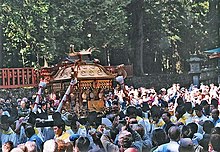Mikoshi
A mikoshi (Japanese: 神輿) is a sacred religious palanquin (also translated as portable Shinto shrine).
Often, the mikoshi resembles a miniature building, with pillars, walls, a roof, a veranda and a railing.
Among the first recorded uses was when in the year 749, the deity Hachiman is said to have been carried from Kyushu to Nara to worship the newly-constructed Daibutsu at Tōdai-ji.
The body, which stands on two or four poles (for carrying), is usually lavishly decorated, and the roof might hold a carving of a phoenix.
Some shrines have the custom of dipping the mikoshi in the water of a nearby lake, river or ocean (this practice is called o-hamaori).







